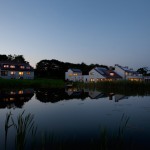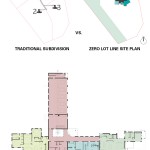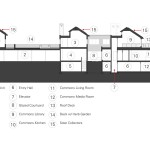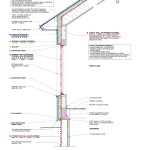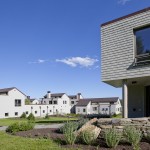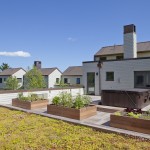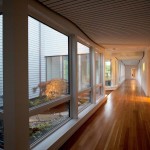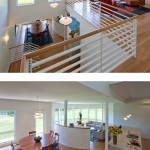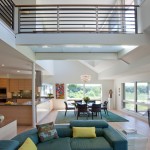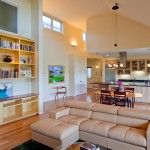Coastal Co-Housing Community
Project Name
In this small co-housing development, three couples, committed to environmental stewardship and intelligent retirement housing, have realized their dream of aging gracefully and creatively together.
The project is located on a 16-acre coastal site on which a standard subdivision with five separate houses was permitted by zoning. However, the zoning ordinance also made it possible to construct a zero-lot-line subdivision if 40% of the land remained open space. The tight clustering of this project ensures that 80% of the property will remain open. The main building is a unified composition of three homes and a commons, the latter complete with living and kitchen area, library, media room, workout room, art studio, roof deck with kitchen garden, shared HVAC systems, central garage, and an apartment for a future caregiver. The separate guesthouse has a living area, five bedrooms, and a basement playroom. Both buildings are sited and designed to maximize views, cross-ventilation, and opportunities for natural light and solar collectors. The design preserves individual privacy while encouraging interaction.
The integrated design process began with an all-day meeting to develop goals and objectives for the project. These included encouraging interaction between the residents; an internal connection between units; high expectations for energy efficiency; universal access; and durable, low maintenance materials.
In the main building has one, fully accessible “front door”. After entering, residents and visitors proceed past a planted interior courtyard to a generous hallway with an undulating wood ceiling, the “spine” of the building that connects the individual units and the commons. All the units are or can be made fully accessible: One unit is on a single level; another has a stair wide enough for a future lift, the third has stacked storage closets for easy conversion to an elevator, and an elevator makes the three floors of the commons accessible. The accessible first floor of the guesthouse includes a bedroom suite.
A wood pellet boiler and solar collectors provide heat and hot water. A 25 KW solar array provides electricity; more is possible. Maximizing space for collectors was one determinant of building form.
Every unit in the main building has multiple exposures. Windows were located to provide views, natural light, and good ventilation without compromising privacy. Care was taken to provide no more glazing than necessary. While each unit has a unique plan and character, the complex has a unified aesthetic and scale that reinterpret indigenous New England architecture.
Architecture or A/E Firm Name
Architect
Team
Consultants
Location
Client
General Contractor
MEASURE 1: DESIGN & INNOVATION
Combining four structures into one increases efficiency by centralizing functions, minimizing the building footprint, and reducing exterior surface area. In the truly integrated design process, the owners, design team, and builder worked together from initial programming through design to completion. The design maximizes opportunities for interaction and mutual support without compromising individual privacy.
MEASURE 2: REGIONAL COMMUNITY DESIGN
The design reinterprets New England vernacular and blends green elements and durable materials into a contemporary, yet timeless aesthetic. “Chimneys” gather the mechanical intakes and exhausts, reducing penetrations and giving visual identity to the individual units. The project is located less than four miles from village shopping, and all the residents work out of home offices.
MEASURE 3: LAND USE & SITE ECOLOGY
The tight clustering of buildings ensures that 80% of the property remains undeveloped. The common garage reduces paved surfaces and, possibly, the number of cars. Near the buildings, landscaping uses native plants; most of property, a former farm, is left as meadow.
MEASURE 4: BIOCLIMATIC DESIGN
The buildings are sited and designed to maximize views, cross-ventilation, and opportunities for natural light and solar collectors. Flat roofs are vegetated to retain runoff and to reduce cooling loads. Solar shading devices and deep eaves reduce solar heat gain.
MEASURE 5: LIGHT & AIR
All rooms have ample day-lighting and cross-ventilation. There is less glazing on the north and west elevations to reduce solar gain and heat loss. All units have energy recovery ventilation systems.
MEASURE 6: WATER CYCLE
Water efficient fixtures are used throughout. Vegetated roofs retain and filter runoff. Native and low maintenance plantings reduce need for active landscape watering.
MEASURE 7: ENERGY FLOWS & ENERGY FUTURE
The envelope is super-insulated (walls at R-45, roof at R-65, triple-glazed windows) with very high levels of air tightness. A central wood pellet boiler and solar hot water collector provide heat and domestic hot water to all units, including the separate guesthouse. Installed solar PV is 25 KW, with additional roof area available.
MEASURE 8: MATERIALS & CONSTRUCTION
Exterior walls were tested for air tightness with a fog machine. All exterior materials are low maintenance; locally available cedar shingles clad the walls. No- or low-VOC materials are used throughout the interior.
MEASURE 9: LONG TERM FLEXIBILITY AND ADAPTABILITY
Both buildings have universal accessibility. Because three dwelling units and the commons are in one building and connected by a heated hall, additional adaptive reuse scenarios are possible. The caregiver apartment extends possibilities for aging-in-place.
MEASURE 10: COLLECTIVE WISDOM & FEEDBACK LOOPS
Overall energy use is tracked using utility invoices. Energy distribution is measured with eMonitor, web-based inverters, and Btu meters, so that overall energy use can be further reduced and/or offset by additional solar panels. Total energy usage for one typical year is 25.6 kBtu/SF/yr. Of that total, 23.4 kBtu/SF/yr is from wood pellets, a mostly renewable energy source.

